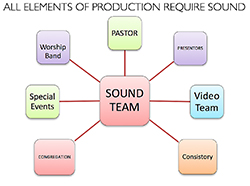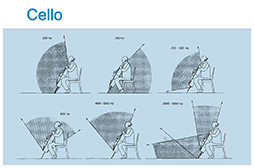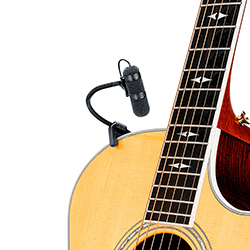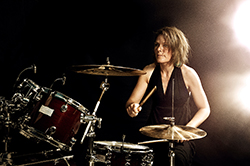
By Vincent Gabriel Antonini, CTS
Close your eyes. You’re at a worship service. The visuals are gone, and all you have left is sound.
That’s where the information happens.
 Accordingly, in any church, the sound engineer is central to the outcomes of the worship experience (good or bad). The sound engineer volunteer or professional needs to be the central cog in the wheel of activities. All activities in these types of facilities rely on sound, whether it’s a choir, worship band, pastor’s sermon, or a video playback from a foreign mission trip. There needs to be a person to lead this process. It’s the responsibility of the sound engineer to facilitate the techniques to ensure a successful production, whether it’s instructing the field team how to use boom and body-worn microphones in harsh conditions, or working with the band to achieve a clear monitor mix for the band. The sound engineer needs to know what the challenges are — why someone isn’t comfortable speaking; why someone seems shy near the microphone; why the band is so loud. They can ask themselves questions like, Does the pastor have the right microphone on? and Do I need to teach proper microphone technique to all users?
Accordingly, in any church, the sound engineer is central to the outcomes of the worship experience (good or bad). The sound engineer volunteer or professional needs to be the central cog in the wheel of activities. All activities in these types of facilities rely on sound, whether it’s a choir, worship band, pastor’s sermon, or a video playback from a foreign mission trip. There needs to be a person to lead this process. It’s the responsibility of the sound engineer to facilitate the techniques to ensure a successful production, whether it’s instructing the field team how to use boom and body-worn microphones in harsh conditions, or working with the band to achieve a clear monitor mix for the band. The sound engineer needs to know what the challenges are — why someone isn’t comfortable speaking; why someone seems shy near the microphone; why the band is so loud. They can ask themselves questions like, Does the pastor have the right microphone on? and Do I need to teach proper microphone technique to all users?
 To ensure success, the sound engineer must mimic a Christ-like approach. If he/she doesn’t, the production may derail. The engineer needs to remain calm and deal with multiple personalities. And really, we all want the same thing: premium sound. We want a service that sounds as if there are no microphones at all; just accurate, and intelligible.
To ensure success, the sound engineer must mimic a Christ-like approach. If he/she doesn’t, the production may derail. The engineer needs to remain calm and deal with multiple personalities. And really, we all want the same thing: premium sound. We want a service that sounds as if there are no microphones at all; just accurate, and intelligible.
So, how can we get there?
When it comes to miking a worship band, using proper techniques can ensure premium sound for the vocalist and band. Every microphone should receive the same amount of care and consideration as the pastor’s microphone. While some members may prefer the sermon from the pastor, others may desire the hymns and sounds from the choir or worship band. It’s ideal for every church to have a simple, elegant solution to capture the pure sound of its live elements.
The bottom line is: If you want premium sound consistently, it will require organizational cooperation. Sound is invisible, and typically only bad sound is noticed. When microphones do not possess properties such as on/off axis linearity at all frequencies and angles, a fast impulse response, and high SPL handling, we notice the inaccuracies and frequency shifts that occur due to the microphone’s inability to produce a 360-degree flat frequency response. The ear and brain are hard-wired to receive accurate sound. Thus, when the sound becomes unnatural and unintelligible. This normally ends with the user experiencing “listening fatigue” prematurely.
Try to avoid comb filtering, or instances where a source might be compromised due to the direct versus indirect sound capture. In other words, direct sound — along with unwanted reflected source sound — might be entering the same microphone at different times. The filtering that arises when a signal is added to itself after having been delayed in time is called a comb filter. Comb filtering is rarely intentional, but it’s heard all the time in sound productions, where it can arise both acoustically and electrically. This situation is a daunting task to remedy for the engineer, and often results in an unintelligible experience for the congregation. In order for this delay to not affect the sound field at the microphone position, the reflection must be attenuated by at least 10 dB and preferably 15 dB. Try to minimize reflected sound.
Mr. Proximity
Depending upon how a microphone is calibrated at the factory for proximity effect (low energy buildup), this can cause speech to be unintelligible. So, don’t get the

microphone too close to the pastor, or the speech might become muffled. Tonal balance is attained through using the correct distance specified in the manufacturer’s directional microphone’s distance calibration. Pressure-gradient microphones should be calibrated for different uses, such as a lecture or using a boom microphone for dialogue recording. One setting does not work for all, and once low energy is recorded, it is close to impossible to remove. It is like trying to un-bake a cake!
Instrument know-how
Knowing the dynamic style of your musicians and the directional radiation pattern of their instrument is vital in helping you properly mic their instruments. Typically, a super cardioid microphone mounted directly on the instrument is ideal, especially when it has a linear on/off-axis frequency response. This mic will give the  engineer more gain before feedback and may assist the engineer to attain a more concise, clear mix.
engineer more gain before feedback and may assist the engineer to attain a more concise, clear mix.
A supercardioid microphone like the 4099G is a fantastic choice for acoustic guitar, especially because we can experiment easily with the microphone sound capture simply by angling via the gooseneck mount. This will give us options regarding the tone we prefer from the instrument. The d:vote 4099 instrument solution offers mounting for most instruments as well as wireless adaptors for third-party manufacturers.
We want an acoustic guitar to sound like six strings. So, we also need our microphones to have a lightning-fast impulse response so we don’t miss any nuance of the resonating strings.
Also, using directional microphones would allow the engineer more level control over the sources. This approach is more deductive and can let you design your event by what you wish to reject from each microphone. It’s what I like to call “designing by rejection” — essentially, making sound  decisions primarily based on what we don’t want to hear.
decisions primarily based on what we don’t want to hear.
Another sound trap is using a specific microphone because it changes the complexion of the instrument. An example would be using a kick drum microphone because it has a rise in the low frequency. It sounds big when soloed; most times, though, we end up cutting out the artificial low-end. Why? Because you shouldn’t need to boost the low energy of a low-energy instrument!
In other words, break the mic muscle memory; use microphones that are ideal for all types of sound capture. My suggestion is to leave the EQ for deductive-type applications and let the microphones do their job. If angled correctly, your mix balance will sound amazing and, most of all, natural.
Now, consider tech tools that can help
For live sound engineers in the house-of-worship market, tools such as the Smaart System Measurement Acoustic Analysis Real-time Tool (SMAART), or SIM from Meyer Sound Laboratories — both Audio Analyzers — can be coupled with an accurate microphone, such as the DPA4006A, and used to tune a sound system to prevent feedback conditions. So, performers can accurately hear themselves and their band mates, letting them perform optimally.
 This ensures the microphones’ response at all positions on the stage are working in conjunction with the reinforcement system. You’re getting a true image of how to set the EQ curves of all those different angles. Here, the linearity comes back into play, because the microphone that’s onstage comes back onstage after it comes out of the speakers and reflects off walls, chairs, and other elements of the facility. What does that sound like coming into the microphone at a strange angle? If there is a stray frequency that causes issues off-axis and is, for example, at 3k, then we need to reduce that frequency, which will then result in important information for intelligibility being cut out. If the system is tuned properly, then we can retain the important information that we need to hear optimally.
This ensures the microphones’ response at all positions on the stage are working in conjunction with the reinforcement system. You’re getting a true image of how to set the EQ curves of all those different angles. Here, the linearity comes back into play, because the microphone that’s onstage comes back onstage after it comes out of the speakers and reflects off walls, chairs, and other elements of the facility. What does that sound like coming into the microphone at a strange angle? If there is a stray frequency that causes issues off-axis and is, for example, at 3k, then we need to reduce that frequency, which will then result in important information for intelligibility being cut out. If the system is tuned properly, then we can retain the important information that we need to hear optimally.
What I’ve described is an all-too-common situation. Realistically, however, many churches are subject to budget restrictions when it comes to their acoustic design and equipment setup. That said, it’s important (and certainly cost-effective) to have a strong training program in place. Many resources are available online for free, and a lot of vendors offer these sorts of tutorials and training at no charge. One great example, of course, is DPA’s Mic University.
When it comes to equipment selection on a strict budget, be sure to buy the best microphone you can afford that possesses the proper attributes that are needed for your production. After that, invest in the best-quality console and speaker reinforcement system you can afford. You want to follow this buying sequence because it’s difficult and time-consuming to make a below-average microphone sound good enough, even if your sound system is a premium one. But, a great microphone can and will make an average system sound very good and with a high degree of intelligibility, which is the name of the game regarding the spoken word.
 Putting the lion’s share of your budget into the microphones is your first line of defense against unintelligibility. DPA
Putting the lion’s share of your budget into the microphones is your first line of defense against unintelligibility. DPA
is world-renowned for delivering unbeatable natural/accurate sound. Along with the array of mounting accessories offered, this ensures an uncluttered stage area.
Strategic microphone selection and placement play a vital role in successful productions. Sound is invisible and, when unnoticed, is most likely because it sounds great!
One last rant
All too often, we invest time and money into mission trips that are solely intended to assist the outreach of the church and to help people in many unstable areas of the world. How many times have you been in church waiting to view video of a mission trip, just to be very disappointed in the sound capture? It’s not always the fault of the recordist; however, great microphones are not the only answer.
 Often, there simply isn’t enough hands on deck, and too much gear to be operated. The result is decent video quality and horrid sound capture.
Often, there simply isn’t enough hands on deck, and too much gear to be operated. The result is decent video quality and horrid sound capture.
Well, there’s some great news — especially if you record video with your iPhone or Mac/PC laptop. DPA recently released the d:vice™ Digital Audio Interfaces, which are very compact and lightweight. The specifications of the d:vice are greater than any DPA microphone made. This results in a “no-compromise” premium-quality sound capture through your iPhone or laptop. It can be configured through the DPA d:vice APP for stereo, dual or mono functionality. It also has four presets and hi-pass filtering on each channel to help reduce unwanted low energy from your recording. The best part is that you can lock out the gain settings so the video team is guaranteed to get spectacular sonic detail. It can also be paired with most DPA microphones, including the d:vote, d:screet and d:dicate microphone families. Therefore, you can easily have a traditional broadcast interview setup with a boom mic and body-worn microphone — or a stereo pair of d:screet 4061, for example — to capture live music or film sound. Another possibility could be a pair of DPA d:dicate 4011 microphones on a concert piano for stellar results right into your iPhone. Additionally, the d:vice is a core appliance and will work with most third-party apps and software programs. For the tech-heads, the d:vice has 114dB of dynamic range and can attain high sampling rate of 96kHz. Hey, your next mission trip or recital can now sound professional and be used by volunteers and professionals alike!
Getting great sound is subjective
These suggestions are meant to be a good starting point. Remember: a confident performer will always sound better!
In a church, it’s all about information. We can close our eyes and get the information we need just from the sound — and that’s why it really needs to be accurate.
Thank you for listening!
— Gabriel
Vincent Gabriel Antonini, CTS, is National Sales Support/Business Development Manager for DPA Microphones in USA.


